Minimally invasive chop technique effective for hard cataracts
Central impaling of the nucleus and centrifugal cracking keep surgical maneuvers within the area of the capsulorrhexis
ROME – A minimally invasive phaco chop technique based on centrifugal cracking of the nucleus from the center to the periphery can deal effectively with hard nuclei, greatly reducing surgical times, according to a speaker here.
“More than 60% of the cataracts we see at our clinic are at a very advanced stage. Our technique is a combination of different maneuvers we have learned from expert colleagues. On this basis we have developed a personal approach that is proving particularly safe and effective on this type of nuclei,” said Giorgio Lofoco, MD, at the Italian Ophthalmology Society meeting.
Impaling, segmenting the nucleus
| Capsulorrhexis marker |
| Giorgio Lofoco, MD, and colleagues Antonio Bardocci, MD, and Francesco Ciucci, MD, use a corneal marker to size and center the rhexis. The light epithelial mark does not cause patients to complain about postoperative pain or foreign body sensation, they said. In a preliminary series of 50 cases where the corneal marker was used, capsulorrhexis was found to be postoperatively more frequently centered and correctly overlapping the IOL circumference, and a significantly lower incidence of IOL pea-podding was reported. With white or brown cataracts, in the absence of a red reflex to make the corneal mark visible, both the corneal marker and the anterior capsule are stained with trypan blue to maximize visualization during capsulorrhexis. (For more on this topic, see OSN Europe/Asia-Pacific, November 2002, page 21.) |
Surgery is performed under topical anesthesia using xylocaine gel. A 6-mm corneal marker is used to achieve a well-done, well-centered 5-to-5.5-mm capsulorrhexis.
A 3-to-3.2-mm incision in clear cornea is made between 9 and 11 o’ clock, and a 1-mm paracentesis is performed at 2 o’clock. Healon GV or Healon5 (sodium hyaluronate, Pharmacia) are then injected into the anterior chamber.
“We break nucleus resistance by embedding the phaco centrally, 3 mm vertically inside the nucleus. While doing this maneuver, we calibrate aspiration so the downward pressure of the phaco tip is counterbalanced by an opposite suction force, which maintains the lens in place. This way there is little if any traction on the zonules,” he said.
Once the nucleus is impaled, a medium-high vacuum of 100 to 180 mm Hg is maintained while the following cracking maneuvers are performed using a Neuhann chopper.
“Starting 1 mm from the embedded phaco tip, the chopper makes a first crack pulling from the center to the periphery, then a series of subsequent cracks with similar maneuvers, thus dividing the nucleus in a number of segments proportional to the hardness of the nucleus,” Prof. Lofoco said.
Safe, visible maneuvers
The cracking maneuvers performed from the center to the periphery are not only more effective, but also safer and more controllable, Prof. Lofoco said.
“The tip of the chopper is always visible; it never disappears under the rhexis edge or behind the cortex. We can also safely perform these maneuvers with miotic pupils because all we need to see is the center of the nucleus, the embedded phaco and the action of the chopper, which is all there in our sight,” he said.
Emulsification is carried out by lifting the single segments of the cracked nucleus with a Buratto spatula, under the same medium-high vacuum.
“There are variants to this stage of surgery,” Prof. Lofoco said. “Either you emulsify each single segment as soon as you have cracked it, or you do all the cracks first and then emulsify the segment one by one. This is better done alternating the segments, to avoid emptying the capsular bag on one side and maintain a well-distended capsule.”
Many advantages
There are many advantages to this technique, Prof. Lofoco said in conclusion. Zonular traction is reduced, and all the maneuvers take place within the area of the capsulorrhexis.
“We are operating at a safe distance from the posterior capsule, and we are not using sharp or pointed instruments that could come into contact with it. Phaco time and power are reduced, even with very hard cataracts,” he said.
However, he added, like all chop techniques, this procedure is not suitable for soft nuclei.
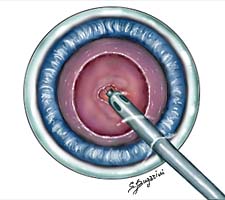 | 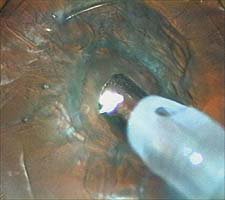 |
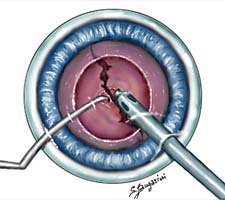 | 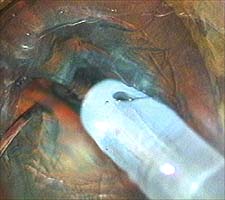 |
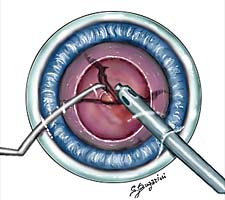 | 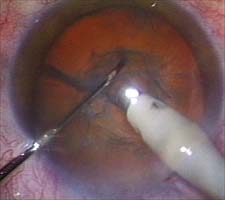 |
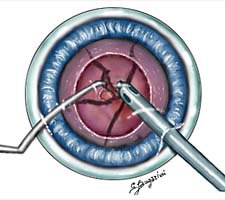 | 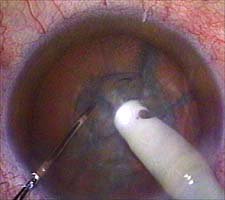 |
| Once the nucleus is impaled, a medium-high vacuum of 100 to 180 mm Hg is maintained while a Neuhann chopper makes a first crack pulling from the center to the periphery, then a series of subsequent cracks with similar maneuvers, thus dividing the nucleus in a number of segments proportional to the hardness of the nucleus. | |
For Your Information:Giorgio Lofoco, MD, can be reached at Studio Lofoco, Viale Giulio Cesare 47, 00192 Rome, Italy; (39) 0632-15152; fax: (39) 06233-17535; e-mail: dr.bardocci@bardocci.it.
